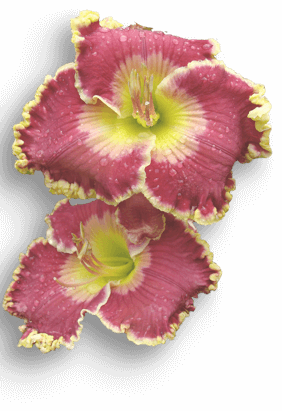why do we love the daylily?
Dazzling and Diverse
Over four millennia ago, Chinese oral tradition said that what we know today as the genus Hemerocallis was used both for medicinal purposes as well as food from its buds and roots. Over two millennia ago, Confucius first documented it in a poem. The plants remained mostly used for their medicinal properties until brought to Europe in the 1500s. Visit out FAQ page and learn more, or scroll below to explore various topics.
Why Grow Daylilies?
New Garden Palette Each Day
Yes, each flower really only lasts ONE DAY. The word Hemerocallis is derived from two Greek words meaning “beauty” and “day.” The flowering period of an established clump is usually several weeks long. Many cultivars have more than one flowering period! Although not required, many gardeners prefer to “deadhead” spent blooms each day so the plantings look clean and new blooms are able to open unobstructed.

All Colors of the Rainbow
Since the early 1930s, hybridizers throughout the world have made great improvements in daylilies. Originally, the only colors were yellow, orange, and rusty red. Today, we have colors ranging from near-whites, pastels, yellows, oranges, pinks, vivid reds, green, deep crimson, purple, neon pink, nearly true-blue, and many fabulous blends and eye-popping multi-colored patterns.

Diversity in Size, Color & Form
Daylilies offer a wide range of bloom sizes, scape height and bloom time. By carefully selecting plants, daylilies will show off in the garden from early May to late October, depending on zone. Some blooms can reach 15” across, while some daylilies grow to be over 60” tall. A trio of daylilies in various sizes and shapes planted together in a mixed bed provides a firework of color throughout the season, while maintaining a good foliage structure.

Easy to Obtain, Grow & Propagate
There are dozens of reliable sources available for every budget and taste through the American Daylily Society Source List and local daylily clubs. Daylilies can thrive in most ordinary top soils without any required fertilizing or insect control measures. Daylily cultivars will generally multiply each year forming a robust clump of fans rather than dying out over time. Additionally, modern varieties do not encroach upon other plants and spread into unwanted areas — they’re perfectly behaved perennials.
Daylily Dictionary
Hundreds of terms defined and vetted by the American Daylily Society Scientific Studies Committee, and most all have images or links for further learning.
Regions
The American Daylily Society is organized into geographic regions to help you find local groups, sources and meetings.
Daylily FAQ
Have questions? We've got answers. Start here for some of the most commonly asked questions, or use the CONTACT US link at the top of every page to ask a question of your own.
Display Gardens
There are more than 330 American Daylily Society Display Gardens throughout the United States and parts of Canada where you can view a variety of modern daylilies in a garden setting.
Elevating Your Experience
Become a Daylily Judge!
There are two types of judges training offered to members of the American Daylily Society – Garden Judges and Exhibition Judges.
Garden Judges
Garden judges learn to perform consistent and impartial evaluation
of daylily performance in garden settings. They judge annually by
casting a provided ballot for individual cultivar awards.
Exhibition Judges
Exhibition judges are also known as “flower show judges.”
They judge by invitation at accredited flower shows.

Show off!
Entering A Daylily Exhibition
The American Daylily Society mission statement includes the desire to provide the general public with education and exposure to the daylily. To help with this mission, members and local daylily groups choose to host daylily shows. Entering a show is fun, and winning is an art. Let us help you be more successful at both!

The American Daylily Society

